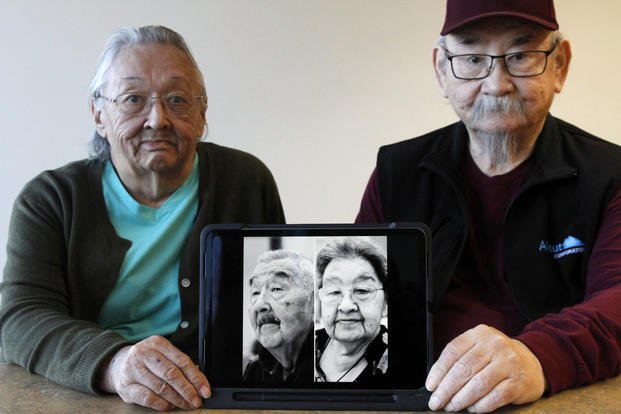ANCHORAGE, Alaska (AP) — Gregory Golodoff spent most of his years on a quiet Alaska island, living an ordinary life, managing a co-op store, fishing for crab and serving as the village council president. But Golodoff’s recent death at the age of 84 has reopened a chapter of American history and stirred up memories of a long-forgotten Japanese invasion that prompted the only World War II battle on North American soil.
Golodoff was the last survivor among 41 residents imprisoned in Japan after Japanese troops captured remote Attu Island during World War II. He was 3 when the island was taken. He died Nov. 17 in Anchorage, his family said. His sister, Elizabeth “Liz” Golodoff Kudrin, the second-to-last surviving Attuan, died in February at 82. Three of their siblings died in captivity.
“The eldest generation has passed away to the other side,” said Helena Schmitz, the great-granddaughter of the last Attu chief, who died in Japan along with his son.
Attu is a desolate, mountainous slab of tundra, about 20 miles wide by 35 miles long, and sits between the North Pacific Ocean and Bering Sea on the volcanic Ring of Fire. It’s the most westerly island in the Aleutian chain — closer to Russia than mainland Alaska — and was one of just a few U.S. territories, along with Guam, the Philippines and the nearby island of Kiska, taken by enemy forces during the war.
The American effort to reclaim Attu in 1943 amid frigid rain, dense fog and hurricane-force winds became known as World War II’s “forgotten battle.” About 2,500 Japanese soldiers perished, many in hand-to-hand combat or by suicide; 28 survived. Roughly 550 U.S. soldiers died. Initially trained and equipped to fight in the North African desert, many suffered from frostbite and exposure due to inadequate gear.
Even after the surviving captives were freed at the close of the war, they were not allowed to return to Attu because the U.S. military decided it would be too expensive to rebuild the community. Most were sent to the island of Atka, about 200 miles (322 kilometers) away.
With the loss of their homeland, the Attuans’ language, Sakinam Tunuu, is now all but gone, spoken only by members of Schmitz’s immediate family. The distinctive basket-weaving style of the island is practiced by just three or four weavers, and not all are of Attuan descent. Schmitz runs a nonprofit named Atux Forever to revive the cultural heritage.
Much of what is known about the Alaska Natives’ time in Japan is chronicled in the book “ Attu Boy,” written by Golodoff’s older brother, Nick, with assistance from his editor, Rachel Mason, a cultural anthropologist with the National Park Service in Anchorage.
Mason knew the three siblings. Gregory and Liz had little memory of Attu or Japan, and neither liked to talk about it, she said.
Nick Golodoff, who was 6 when he was captured, had a childlike innocence about his time as a prisoner, Mason noted. The cover of his book featured a photograph of him riding on the back of a Japanese soldier, both smiling.
That experience was far from typical. Of the Attu residents interned in Japan, 22 died from malnutrition, starvation or tuberculosis. Schmitz’s great-grandfather, Mike Hodikoff, died with his son of food poisoning from eating rotten garbage while in Japanese captivity, the book noted.
Japanese soldiers landed on Attu Island on June 7, 1942, when residents were attending services at the Russian Orthodox church. Some ran for their rifles, but Hodikoff told them, “Do not shoot, maybe the Americans can save us yet,” according to the book.
Instead, the village radio operator, Charles Foster Jones, was shot and killed before he could alert authorities, becoming the only U.S. civilian killed by the invading forces in North America, according to a tribute to Jones by the National Oceanic and Atmospheric Administration.
The other residents — all Alaska Natives except for Jones’ wife, a white teacher from New Jersey named Etta Jones — were kept captive in their homes for three months before being told to pack up and bring what food they could for the journey to Japan.
They first went to Kiska, another Alaska island; one Attu resident died on the way. Stuffed in the cargo hold of a ship, the others embarked on a two-week voyage to Sapporo, the largest city on Japan’s Hokkaido Island, where they were kept in four rooms in an abandoned dormitory. Only Etta Jones was separated from them and taken in a different boat to an internment facility in Yokohama, south of Tokyo.
One Japanese guard complained the Attuans ate better than the Japanese, but conditions worsened when the Alaskans ran out of the food they brought.
The Golodoffs’ mother, Olean, and others were forced to work long hours in a clay mine. As their numbers dwindled, she also became the cook for the surviving POWs, though there was little to make. She was reduced to gathering orange peels off the street and cooking them on top of a heater, said George Kudrin, who married Olean’s daughter Liz in Atka after he returned from the Vietnam War.
“I fed them to my children, and only then would they stop crying for a while,” Olean once told an interviewer.
Her husband, Lawrence, and three of their seven children died in Japan. Nick Golodoff lived until 2013. Another son who survived captivity, John, died in 2009.
Kudrin said Olean didn’t speak of her experiences in Japan, and his wife, Liz, was too young to remember anything.
“She always knew that she was part of the history of World War II and she always said, ‘I am a survivor with my mama,’” he said.
American forces reclaimed Attu on May 30, 1943, after a brutal 19-day campaign. Much of the fighting was waged in dense fog amid winds of up to 120 mph. Attu Island today is part of the Alaska Maritime National Wildlife Refuge and known more for being one of the top destinations in North America for groups dedicated to viewing birds, especially those from Asia.
Greg Golodoff’s wife of 50 years, Pauline, said he never spoke with her about his experience in Japan or about being the last living resident of Attu.
“I tried to ask him, but he didn’t want to talk about it,” she said.











